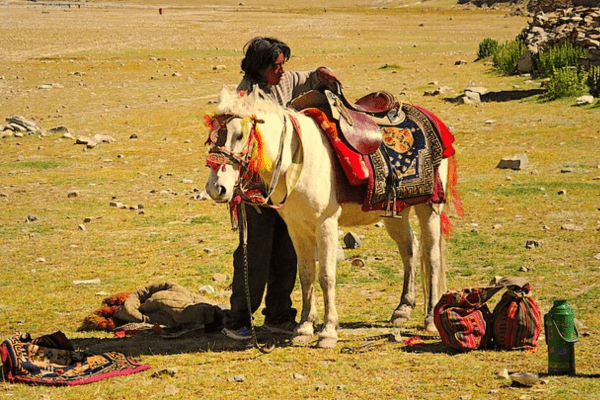The Nangchen horse, a unique and pure breed native to the Kham region in northeastern Tibet, boasts a heritage steeped in ancient tradition. This small but resilient breed was first brought to international attention in the late 20th century by the efforts of Michel Peissel, a renowned French anthropologist.
Distinct for its prolonged isolation, the Nangchen horse has been selectively bred for over 14 centuries, maintaining its lineage free from Arabian, Turkish, and Mongolian influences. This remarkable isolation has not only preserved its purebred status but also highlighted its significance as a living relic of equine history.
History:
The rich past of the Nangchen horse can be found buried deep within Tibet’s high altitudes, providing an intriguing picture of history and adaptation.
Ancient References: These horses first made an appearance in Chinese historical documents predating even Mongol invasions of China. These references suggest a longstanding recognition of their significance to this region.
Origin in Obscurity: Believed to have originated around the 9th century, the Nangchen horse remained obscure for much of Western history for centuries due to its remote habitat in Tibetan highlands – contributing further to its unnoticed status across borders.
Dr. Michel Peissel’s Exploration: Not until 1994 did significant light be shed on this breed thanks to Dr. Michel Peissel’s investigative efforts; his groundbreaking research brought new insight into its development, behavior and physical characteristics of Nangchen horses.
Dr. Peissel embarked on extensive travels across Tibet in search of the Nangchen horse referenced in ancient Chinese texts from as far back as 6th century. Not only was his journey geographical but it was also rich with historical and cultural knowledge about this mysterious horse referred to by Chinese textual sources.
Adaptation to Extreme Altitudes: Nangchen horses have traditionally been bred by Tibetan nomads at altitudes exceeding 15,000 feet, giving rise to their unique physical and physiological traits including robust strength and resilience – evidence of the breed’s ability to thrive under such harsh high-altitude conditions.
Comprehensive Studies: Dr. Peissel returned to Tibet for further studies in 1995, performing extensive investigations ranging from skeletal analysis, physical measurements, cardiopulmonary assessment as well as collecting hair and blood samples to create a genetic profile of Tibetan dogs.
Physical Characteristics
Nangchen horses are well known for their small stature, typically standing 12-14 hands high. Yet despite this small stature, these horses remain extremely sturdy and agile despite their diminutive stature.
Their thick coat helps them endure high altitude conditions more comfortably while boasting strong compact bodies with deep chests, well proportioned heads with straight profiles and impressive stamina levels make these impressive animals standout among their competition.
Temperament and Abilities:
These horses are known for their hardiness and endurance. With an exceptional ability to traverse difficult mountainous terrain, these horses make for invaluable transportation and herding in the region.
While their temperament tends to be generally calm and gentle, their spirits often remain lively as their survival instincts come into play in a demanding environment.

Cultural Significance
Horses play an integral part of Nangchen life; they represent status, wealth and cultural heritage. Horse festivals in Nangchen provide an exciting showcase of this breed’s beauty through racing events, traditional music performances and colorful attire; not simply competitions but celebrations of the deep bonds between people and horses in Nangchen.
Conservation and Modern Challenges
The Nangchen horse breed faces numerous threats due to modernization and environmental changes.
Numbers have fallen significantly due to factors like urbanization and lifestyle shifts affecting its traditional breeding grounds. Conservation efforts must continue in order to maintain this unique species that holds genetic as well as cultural value.

